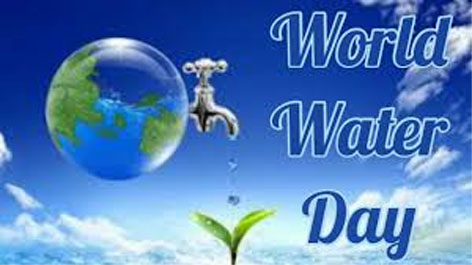Er. Vinod Kumar
But unfortunately a large number of our fellow human beings do not get enough water. Taps running dry, long queues for water, fights, marches and protests for water have become a common sight. There is increasing scarcity of water due to climate change, population growth, pollution, industrial development, deforestation, mismanagement and other factors. There are some disputes on water among states and even among countries. It has been rightly said
WORLD WATER DAY
” If current wars are fought for land, the future wars may be fought for water.”
Realizing the urgency of the water scenario at the global level the United Nations, in 1992, decided to celebrate 22nd March every year as World Water Day. The day focuses attention on the importance of universal access to water. A theme is selected for each year. This year the theme is ‘ Water and Climate Change ‘.
Climate change is the greatest threat to humanity. Global temperatures are rising causing drought and forest fires. The theme ‘Water and Climate Change’ explores how water and climate change are interlinked. With the increase in global population, the demand for water increases. This depletes natural resources and damages the environment at many places. Water availability is becoming less predictable at many places. Increased incidences of flooding threaten to destroy water points and sanitation facilities. In some regions, droughts are causing water scarcity and thereby negatively impacting people’s food security, health and productivity.
Scenario of Climate Change in India
India is one of the most effected countries by climate change. The snow ice caps of the Himalayas are experiencing less snow. The glaciers are melting. The rising temperature has started to dry up the rivers. In recent years the Himalayas have experienced warm periods causing a reduction in snow fall. The United Nations climate report predicts that by the year 2035 some Himalayan glaciers will disappear with the rising temperatures. Thus the water will run off into rivers such as the Indus, Ganges and Brahmaputra rivers. This will cause flooding to riverside cites e.g. Varanasi, Kanpur and Patna. These cities have already experienced floods during high monsoon season and it will be ongoing. Flooding will also cause interruption for the farming areas in northern parts of India and cause damage to the roads, bridges and railway lines. The dams in Kosi and Sutlej could overflow causing more destruction to fields and settlements. As the earth’s temperature rises, it will impact agriculture, household, Industries, environment and health. Sea levels will rise substantially. Some parts of the coastal cities around India e.g. Mumbai, Chennai and Kolkata will be underwater. Even most of the islands around India will be covered in water.
Climate Change Mitigation
Climate change adds to the problem of quantity and quality of water. Despite the water resources decreasing, we are taking the water for granted. Most of the freshwater we receive for use is wasted and polluted. The countries will have to cope with the changing patterns of rainfall and dry periods. This will put pressures on the natural resources resulting in increasing conflicts among people over access to scarce water. Humans are building dams and creating waste water treatment plants etc. These arrangements can provide water for agriculture, household, Industrial, environmental and other uses to some extent. But there are other problems associated with these arrangements.
If we don’t address the issue of climate change, there will be more problems in the future which will lead to even more droughts and flooding. It is already leading to significant changes in the world’s physical environment. Extreme weather conditions are becoming more frequent. Animals and plants are responding to earlier seasons.
Climate change can be prevented with proper equipment like weather radars. Factories and cars should be used less because pollution would lead to more global warming. Apart from this most of the existing water supply infrastructure is aging. For instance many of the water pipes were laid down long ago and are now worn out, hence leading to a loss of water. We will have to maintain better water systems.
In the most part of the earth sometimes people burnt fossil fuels (coal, oil, biomass, etc.) to meet their energy needs which release carbon dioxide into the atmosphere. The pollution adds to global warming.
Ensuring that everyone has access to sustainable water and sanitation services is a critical climate change mitigation strategy for the years ahead. Solutions include protecting carbon sinks such as oceans and wetlands, adopting climate-smart agricultural techniques, and increasing the safe reuse of wastewater.
The World Water Day 2020 campaigns that the climate policy makers must put water at the heart of action plans. Water policy plays a pivotal role in how the world mitigates and adapts to the effects of climate change. It is required to devise sustainable agricultural and economic systems that will allow us to decelerate climate change and protect us from extreme weathers. There should be sustainable, affordable and scalable water and sanitation solutions. The Paris Agreement of 2016 brings all nations into a common cause to undertake ambitious efforts to combat climate change and adapt to its effects.
Other Measures
Everyone has a role to play to address the problem of climate change. There are measures which can be taken in order to cope with the climate change. These measures will directly or indirectly help in water saving strategies. These measures include :-
* Reforestration and planting trees to replenish forests
* Reconnecting streams and rivers to floodplains
* Restoring water bodies
* Building reservoirs and dams to store water
* Installing water purification and treatment plants
* Rain water harvesting
* Making artificial glaciers and ice stupas
* Restoration of stepwells / bawlis
* Promoting drip irrigation
(The author is Assistant Executive Engineer (Mech.) PHE Deptt. Jammu)
feedbackexcelsior@gmail.com


